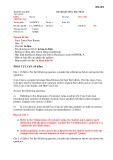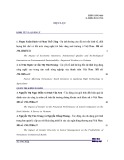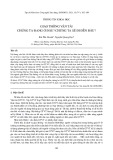
67
Journal of Development and Integration, No. 78 (2024)
Influential factors on the implementation
of strategic management accounting: A case study of
logistics enterprises in Ho Chi Minh City
Phan Hoang Nhat1, Truong Thanh Loc2, Hoang Manh Cuong3,*
1Ho Chi Minh City College of Economics, Vietnam
2Bamboo Capital Group Joint Stock Company, Vietnam
3Nguyen Tat Thanh University, Vietnam
K E Y W O R D S A B S T R A C T
Influencing factors,
Logistics,
Strategic accounting,
Strategic management
accounting.
This study employs both qualitative and quantitative methods by gathering data from
220 survey samples to identify and evaluate the influencing factors on the application of
Strategic Management Accounting (SMA) in logistics companies in Ho Chi Minh City
(HCMC) amidst Vietnam’s transition to a market economy. Through the research, the
authors clarify the influencing factors on the application of SMA, namely competition,
managerial decentralization, and performance, as well as their respective impacts.
Additionally, the study emphasizes the necessity of SMA tools in the context of fierce
competition, especially within the logistics industry. Moreover, it proposes several
recommendations aimed at enhancing the operational quality of logistics companies in
HCMC through the implementation of SMA tailored to this business sector.
* Corresponding author. Email: hoangmanhcuong1996@gmail.com
https://doi.org/10.61602/jdi.2024.78.09
Received: 21-Feb-24; Revised: 18-Apr-24; Accepted: 25-Apr-24; Online: 20-Aug-24
ISSN (print): 1859-428X, ISSN (online): 2815-6234
1. Introduction
In 2003, the Vietnamese Accounting Law
was enacted, recognizing the accounting system
comprising Financial accounting (FA) and
Management accounting (MA). FA is understood
as a system managed by state agencies and must
comply with accounting regulations and standards
set by the government. In contrast, the application
of MA, especially SMA tools, in Vietnamese
enterprises largely occurs spontaneously and
voluntarily, depending on the managerial
information needs. This practice began when
Vietnam transitioned to a market economy, where
business competition intensified. Notably, in the
logistics industry, given its operational intricacies
and financial information requirements, there is a
demand for suitable tools to provide regular and
timely financial information for management. The
question arises as to whether the adoption of modern
management tools and practices helps logistics
enterprises enhance their competitive capabilities
No. 78 (2024) 67-74 I jdi.uef.edu.vn

Journal of Development and Integration, No. 78 (2024)
68
and operational efficiency. This research aims to
introduce different perspectives on SMA tools
in logistics enterprises in HCMC, assessing the
impact of various factors on SMA tool adoption.
The goal is to provide a basis for managers and
policy-makers to promote the development of MA
and SMA in local logistics enterprises.
2. Theoretical framework, hypotheses and
research model
Simmonds first introduced SMA in 1981,
defining it as the use and analysis of accounting
information of the company and its competitors
to develop and monitor business strategies
(Simmonds, 1981). Since then, there has been
an increasing number of related studies on SMA
being implemented (Bromwich & Bhimani, 1994).
Despite numerous studies on SMA, there is no
widely accepted formal definition, especially in
Vietnam and within the logistics field.
Definitions of SMA vary widely, ranging from
multi-stage accounting processes to tools supporting
marketing decisions and market development
(Dixon, 1993; Foster & Gupta, 1994; Roslender,
1995). In Langfield-Smith’s study (2008), SMA is
defined as an integrated process between strategic
management and cost management, aiming to
provide a comprehensive view for managers,
helping them understand competition and resource
optimization better. Conversely, Cadez and Guilding
(2008) propose that SMA not only encompasses
the collection and analysis of financial information
but also integrates non-financial information to
support strategic decisions. This information often
relates to competitors, market structure, customers,
and emerging technology and market trends. This
illustrates the strategic nature of management
accounting, going beyond its traditional role of
cost control and monitoring (Bhimani & Langfield-
Smith, 2007).
In Vietnam, logistics companies are gradually
adopting SMA to compete and dominate the market.
This field is becoming increasingly important
and contributes significantly to the country’s
development. Despite differences in perspectives,
concepts of SMA typically focus on three main
factors: orientation towards the company’s external
environment, long-term orientation support, and
the use of financial and non-financial information
in decision-making (Cadez, 2006). The rapid
development of technology and the business
environment is rendering traditional accounting
inadequate (Kaplan, 1992), particularly in HCMC,
where competition is intensifying. Researching
the factors influencing SMA becomes crucial
to promote the development of this method in
logistics companies in HCMC, helping them
enhance competitive capabilities and operational
efficiency in the market economy.
2.1. The relationship between Competition and
SMA
Competitive factors serve as important
indicators of a company’s ability to deal with
competitors, manage resources, human capital,
and product quality, as well as other factors such as
services, distribution channels, and pricing. Studies
have demonstrated a close relationship between
the application of management accounting (MA)
and a company’s competitive capability (Anh,
2012; Ulrich, 2011). SMA is particularly crucial
in shaping and executing business strategies by
providing financial information, cost management,
evaluating strategic effectiveness, decision
support, monitoring and adjusting plans, as well
as forecasting and planning for the future (Lan,
2019).
The development of infrastructure and economic
renewal policies in Vietnam also contributes to
enhancing the competitiveness of companies.
Applying SMA is not only a choice but also a crucial
requirement for companies to survive and thrive
in an increasingly fierce business environment
(Nguyen, 2022). In other words, competition
drives the application and optimization of SMA,
thereby creating a positive feedback loop between
improving performance and the competitiveness of
enterprises (Tran, 2023). This is not only important
for the success of individual companies but also for
the overall economic development of HCMC and
Vietnam. In a competitive business environment,
companies, especially in the logistics sector in
HCMC, are increasingly focusing on product
diversification, improving quality, and expanding
distribution channels to enhance competitiveness
and better serve customers. The application of
SMA helps companies reorganize their information
systems, leverage diverse information sources to
Phan Hoang Nhat et al.

69
Journal of Development and Integration, No. 78 (2024)
understand and quickly respond to customer needs,
thereby enhancing their competitive advantage.
Therefore, the following hypothesis is formulated:
Hypothesis 1: The level of Competition impacts
the adoption of quality MA in logistics enterprises
in HCMC
2.2. The relationship between Hierarchical
management and SMA
Hierarchical management is a management
approach where decision-making authority is
decentralized to lower levels, allowing them more
autonomy in planning and controlling activities.
This process not only enhances accountability
but also improves organizational efficiency.
Hierarchical management has a close relationship
with SMA, a crucial factor that provides detailed
financial information, supports goal-setting,
strategic planning, budget management, and
evaluates strategic performance.
In the modern business environment, in logistics
enterprises, hierarchical management combined
with the application of SMA helps managers easily
align with common goals and focus. SMA provides
financial and quantitative information for managers
to have a clearer view of the financial and strategic
situation of the company, enabling them to make
informed decisions and timely adjustments. It also
requires close coordination and communication
between management levels and the accounting
department to ensure the smooth and effective
implementation of strategies.
However, managerial decentralization also
brings some challenges, such as difficulties in
unifying common goals. To overcome these
challenges, effective management tools need to be
applied, with SMA playing an indispensable role in
providing necessary information and maximizing
resource utilization. This helps management levels
measure and evaluate the company’s operational
effectiveness, thereby promoting common goals
and improving overall management (Anh, 2012).
Hence, hypothesis 2 is formulated.
Hypothesis 2: The level of Hierarchical
management in a business impacts the adoption of
quality MA in logistics enterprises in HCMC
2.3. The relationship between SMA and Business
performance
SMA is a crucial tool that directly influences
the operational outcomes of a business, not only
through data collection and analysis but also by
aiding in shaping and promoting development
strategies. In the strategy-building phase, SMA
helps assess current financial status, analyze
costs, and project operations, establishing a solid
foundation for strategic decision-making. During
strategy implementation, SMA monitors and
evaluates financial performance, provides regular
reports, and suggests adjustments when needed,
aiming to optimize operations and achieve set
objectives. Additionally, SMA plays a vital role
in financial resource management, tracking and
controlling budgets, costs, and profits, ensuring
efficient resource allocation. The success of a
business relies not only on financial aspects but also
on non-financial aspects, with studies indicating
that the application of SMA significantly improves
operational efficiency (Davila & Foster, 2005;
Hoque & James, 2000).
SMA serves as a measure for the operational
outcomes of a business, helping compare the final
results with the resources utilized. Investing in SMA,
especially in logistics enterprises, is recommended
as a way to accurately assess and improve
operational efficiency. The relationship between
SMA and business performance demonstrates a
close connection between financial management,
performance evaluation, and strategic shaping, all
contributing to the sustainable development and
long-term success of the enterprise.
Hypothesis 3: The extent of applying SMA
in logistics enterprises affects the Operational
outcomes of the business.
3. Research method
3.1. Data
This research utilized statistical figures
encapsulating data collected through interviews
based on well-structured and pre-planned
questionnaires. The research method has
advantages and a level of utility that helps the
interviewees easily understand and accurately
respond to the central focus of the questions.
The interviewees were primarily individuals
with accounting responsibilities in businesses of
various scales. The statistical figures were gathered
Phan Hoang Nhat et al.

Journal of Development and Integration, No. 78 (2024)
70
through meticulous surveys conducted in logistics
enterprises in HCMC. A random sampling method
was applied, with a total of 220 samples collected
and included in the analysis.
3.2. Analysis method
The statistical analysis described was
conducted to examine the characteristics, as
well as the relationships and correlations among
different research variables. Using the collected
data, the method of applying structural equation
modeling (SEM) with the software AMOS will be
implemented to determine the structure reflecting
how the influencing factors relate to the use of
SMA tools.
As the variables (factors) in the model were
constructed based on previous studies, the
validation process was carried out through the
following steps:
- Confirmatory factor analysis (CFA) was
conducted to assess the reliability of the scale, item
simplicity, and convergence of each factor;
- Structural equation modeling was used to test
the hypotheses. The study utilized commonly used
indices such as Chi-square/df, CFI, TLI, RMSEA,
and PCLOSE.
A model is considered acceptable when Chi-
square/df is less than or equal to 2, GFI, CFI, TLI
are greater than 0.9; RMSEA is less than 0.08, and
PCLOSE is greater than 0.05 (Hair, Black, Babin,
Anderson, & Tatham, 2010).
4. Research findings and discussion
4.1. Reflective model analysis
The CFA results show that the Chi-square/df
ratio is less than 2, and GFI, CFI, TLI are all greater
than 0.9; RMSEA is less than 0.08, and PCLOSE is
greater than 0.05. Therefore, the measured factors
are suitable for the collected data. To assess the
convergence, reliability, and discriminant validity
of the factors, the study uses factor loadings,
Cronbach’s Alpha coefficient, Composite reliability,
and Average variance extracted.
The data from Table 1 indicate that all factor
loadings are greater than 0.5; Cronbach’s Alpha is
greater than 0.7; Composite reliability is greater
than 0.6, and Average variance extracted is greater
than 0.5; all these indices exceed the minimum
threshold to ensure convergence, reliability, and
discriminant validity of the factors as proposed
by Hair (2010). Therefore, the factors in the
study ensure unidimensionality, reliability, and
discriminant validity.
The process of conducting structural equation
analysis, which reveals the correlational
relationships among multiple factors, was used as
the basis for identifying multicollinearity cases
(if any). This also implies the foundation for
determining the structure of factors influencing the
application of SMA or the impact of using SMA on
the operational outcomes of many businesses. The
relationships between these factors are presented
in Table 2.
Figure 1. Research model
SMA
adoption
Operational
outcomes
Competition
Hierarchical
management
Phan Hoang Nhat et al.

71
Journal of Development and Integration, No. 78 (2024)
Factor Variable Factor loading Cronbach’s Alpha Composite reliability Average variance extracted
Competition
CT1 0.730 0.890 0.888 0.534
CT3 0.841
CT4 0.885
CT5 0.937
CT6 0.848
CT7 0.752
Hierarchical
management
PC1 0.750 0.892 0.897 0.654
PC3 0.993
PC4 0.932
PC5 0.951
SMA
SMA1 0.795 0.854 0.882 0.527
SMA2 0.795
SMA3 0.931
SMA4 0.926
SMA5 0.831
SMA6 0.651
Operational
outcomes
TQ1 0.750 0.726 0.750 0.605
TQ2 0.991 0.890
Factor Competition
(1)
Hierarchical management
(2)
SMA
(3)
Operational outcomes
(4)
Competition (1) 0.59
Hierarchical management (2) 0.12** 0.74
SMA (3) 0.33** 0.31** 0.58
Operational outcomes (4) 0.20* 0.19** 0.32** 0.54
Table 1. Convergent validity, reliability and discriminant validity of factors
Notes: * Statistical significance at P < 0.05
** Statistical significance at P < 0.01
Table 2. Correlational relationships among research variables
Through detailed statistical figures in Table 2,
it can be observed that there is a significant and
precise correlational relationship among all the
researched factors (with P < 0.05 or P < 0.01)
Chi-square = 157.234; df = 128; Chi-square/df
= 1.231; GFI = .925; TLI = .973,
CFI = .979; RMSEA= .032, PCLOSE =.959
4.2. Structural equation modeling analysis
Based on the constructed hypotheses, combined
with the correlational relationships among the
influencing factors on the application of SMA
identified in Table 2, a structural model has been
developed. The results of the analysis using AMOS
software are presented in Figure 2.
To assess the model’s appropriateness, this
study relies on widely accepted criteria (Hair et
al., 2010) as mentioned above. Through the criteria
used to evaluate the model’s appropriateness, it is
found that the model is entirely suitable for the
collected data.
Phan Hoang Nhat et al.


![Hệ thống thủy lợi: Kết cấu hạ tầng logistics nông nghiệp [Tối ưu SEO]](https://cdn.tailieu.vn/images/document/thumbnail/2025/20250411/vimaito/135x160/7871744364960.jpg)














![Đề kiểm tra Quản trị logistics [mới nhất]](https://cdn.tailieu.vn/images/document/thumbnail/2025/20251015/2221002303@sv.ufm.edu.vn/135x160/35151760580355.jpg)
![Bộ câu hỏi thi vấn đáp Quản trị Logistics [năm hiện tại]](https://cdn.tailieu.vn/images/document/thumbnail/2025/20251014/baopn2005@gmail.com/135x160/40361760495274.jpg)







